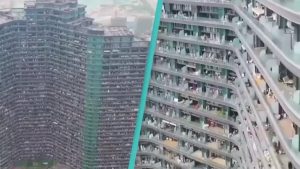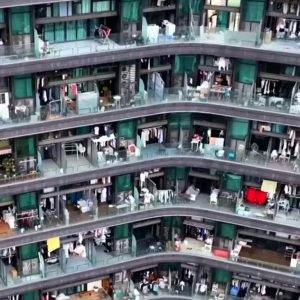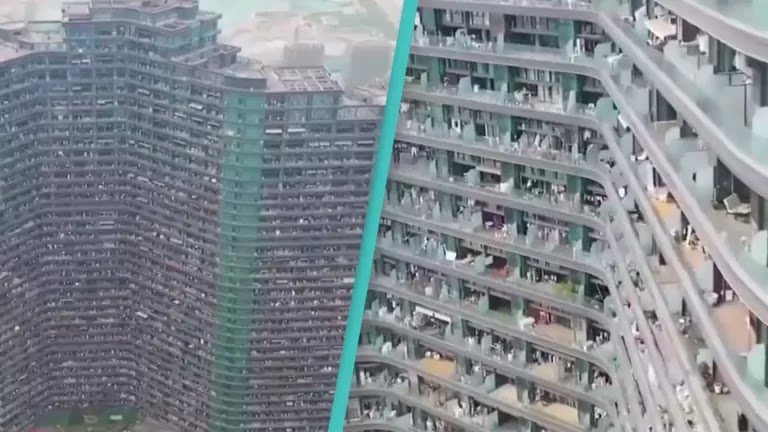Imagine waking up in a building so vast, it’s more akin to a mini-city than a typical apartment complex. You step out of your unit and join a sea of people navigating the hallways—some heading to work, others to school, and many stopping for breakfast at one of the countless eateries on-site. Welcome to the surreal world of Regent International, a towering, self-contained residential complex in Hangzhou, China, that has earned both admiration and critique for its sheer audacity and scale.
A Colossus of Modern Architecture

Regent International, designed by the acclaimed architect Alicia Loo—who also created Singapore’s Marina Bay Sands Hotel—looms 675 feet above the bustling streets below. From a distance, its distinctive “S” shape twists and curves like a giant metallic serpent, shimmering in the city’s skyline. But it’s not just the structure’s form that’s turning heads worldwide; it’s the mind-boggling number of people living inside.
This behemoth can house up to 30,000 residents at full capacity, but currently, around 20,000 souls call it home. Think about that: a population equivalent to a small town crammed into one single building. It’s an entire microcosm contained within steel and glass, offering a rare glimpse into the future of urban living—a future where space is limited, and vertical communities may be our only option.
A Self-Sustaining Ecosystem
Stepping inside, Regent International feels more like a bustling metropolis than a mere apartment building. The lobby resembles a grandiose shopping mall, with floors stretching endlessly into the sky and people flitting in every direction. You pass by cafes, bakeries, bookstores, and even a pet grooming salon. Want to swim a few laps? There are multiple indoor swimming pools. Need groceries? The in-house supermarket has got you covered. Craving something specific to eat? Choose from a dizzying array of restaurants, each catering to a different palate. There’s even a karaoke bar for blowing off steam after a long day.
This is what makes Regent International so captivating: it’s not just a place to live; it’s a self-sustaining urban ecosystem. Residents never really need to leave the complex—everything they could possibly need is just an elevator ride away. The building is its own microcosm, a city within a city, offering all the services and amenities one could hope for. This has made it especially attractive to young professionals and students, who prize convenience and affordability over more traditional concepts of home.
The Perks of Life in a ‘Vertical City’
With rents ranging from a mere $200 to $600 a month, living in this “vertical city” is surprisingly accessible, given Hangzhou’s otherwise competitive real estate market. This affordability has drawn in a diverse community, from aspiring artists and students to IT professionals and young families. The resulting demographic mix is a vibrant tapestry of people from different backgrounds, creating a unique social experiment in how such a dense and varied population can coexist.
This affordability, coupled with the building’s many amenities, has fostered a sense of camaraderie among residents. Neighbors meet in shared spaces like gyms, cafes, and lounges, forging bonds that might not otherwise form in traditional, sprawling apartment complexes. For many, the Regent International is not just a place to sleep at night—it’s a lifestyle, a community, and in a strange way, a family.
When Density Becomes Claustrophobia: The Dystopian Downside
But with great density comes great challenges. Critics have labeled Regent International as a “dystopian utopia,” a paradoxical space where comfort and chaos collide. Concerns about noise, lack of privacy, and potential conflicts among residents loom large. Living in such proximity to thousands of strangers can feel overwhelming, even suffocating at times. The echoes of hundreds of footsteps reverberating through the halls, the hum of a thousand conversations in the communal spaces—it’s a sensory overload that never really quiets down.
One can’t help but wonder: What’s it like to truly live in such a place? Does it feel like a home, or more like a giant hive, with each person a mere drone in the larger machinery of the building? For many, the experience can be as alienating as it is convenient. “There’s always this underlying tension,” says one resident. “So many people, so much activity, yet at times, you feel utterly alone.”
The building’s designers anticipated these issues and attempted to address them by incorporating small private balconies into some units, offering residents a tiny pocket of personal space. These balconies may seem insignificant given the structure’s immense scale, but they provide a crucial psychological break from the crush of humanity inside.
The Grand Vision: More Than Just a Building
Yet, beyond the criticism and controversy, Regent International is undeniably a marvel of modern design and urban planning. It’s a bold attempt to answer one of the 21st century’s most pressing questions: How do we house a rapidly growing urban population in limited space?
In many ways, Regent International is the prototype for what may become the norm in cities around the world. With the global population set to exceed 9 billion by 2050 and more people moving to cities each year, architects and city planners are scrambling to develop solutions. The sprawling, suburban-style housing of the past is simply not feasible for the future. Compact, multi-use “vertical cities” like Regent International might be the key to accommodating this shift.
Moreover, the building’s eco-friendly design serves as a beacon for sustainable urban development. Solar panels, green rooftops, and energy-efficient systems are integrated throughout the complex. This focus on sustainability is not just about reducing the carbon footprint—it’s about creating a blueprint for how dense urban communities can live in harmony with the environment.

A Blueprint for the Future or a Warning?
So, is Regent International a glimpse of what’s to come for urban living, or a cautionary tale of what happens when density overrides humanity? It depends on your perspective. For some, it’s a dream—a convenient, affordable, and vibrant place where everything is at your fingertips. For others, it’s a nightmare—a concrete jungle where personal space is a luxury and the relentless buzz of life never ceases.
What’s undeniable is that Regent International is pushing the boundaries of what we thought possible in urban design. It’s a place where architecture, sociology, and economics intersect, forcing us to rethink our ideas of what a “home” really means.
As cities continue to expand and space becomes ever more scarce, will more of us find ourselves living in these towering, self-sufficient behemoths? And if so, will we thrive in these vertical cities—or merely survive?
Only time will tell, but one thing is certain: Regent International is more than just an apartment building. It’s a symbol of our evolving relationship with urban space—a grand experiment in how far we can push the limits of density, convenience, and community. And whether it stands as a model for the future or a dire warning, it will undoubtedly shape the way we think about city living for decades to come.


